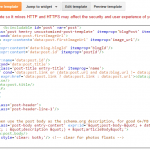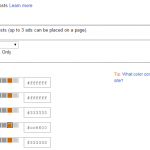The new Blogger widget based template that built on XML specification has a feature to add Google AdSense ad unit inline between posts. These inline ads appear between 2 blog posts on homepage, archive and category or label pages, or after the blog content when the single post is viewed individually. However, the placement is kind of awkward and low performing in term of click through rate (CTR).
A lot of bloggers have put Google AdSense ad code inside the post or wrap the ad unit around blog post by editing template’s HTML to insert parsed ad code manually. Some users may feel uneasy on modifying the AdSense ad code as it may violates AdSense TOS. Anyway, there is another workaround to put AdSense ads in Blogger posts, by using trick to move or duplicate built-in inline ads between posts block to inside the post section.
- To use the trick to move around AdSense ad unit added by Ads Between Posts, enable and configure inline ads in Blogger using this guide. Note that you must login to your AdSense account from Blogger to establish access authentication. If you don’t have AdSense account yet, you can click on Sing Up button to register for one.
- To display this ad within blog post also, click on Template tab, and then click on Edit HTML sub-tab link to open Blogger HTML code template editor to edit the contents of your template.
- Backup a copy of your template by click on Download Full Template or link, in case it’s is needed be uploaded to Blogger server to recover the template in the event of mistake or corruption.
In newer version of Blogger, you can download template by clicking on Backup/Restore button on Template tab.
- Click to tick the Expand Widget Templates checkbox.
In newer version of Blogger, Blogger no longer shrinks any segments. It offers jump to widget feature instead.
- Find the line with the following text:
<data:post.body/>And paste the following block of text before (for ad position before content) or after (for ad position after content) the line above:
<b:if cond='data:post.includeAd'>
<data:adEnd/>
<data:adCode/>
<data:adStart/>
</b:if>
Note that maximum of 3 AdSense for Contents (non Link Unit type) ads are allowed on each page.
- If you want the AdSense ads inside blog post to appear only when individual blog post is visited, and not on homepage, category or archive pages, wrap the following lines to before and after code added above
<b:if cond='data:blog.pageType == "item"'>
</b:if>The whole block added will look like below:
<b:if cond='data:blog.pageType == "item"'>
<b:if cond='data:post.includeAd'>
<data:adEnd/>
<data:adCode/>
<data:adStart/>
</b:if>
</b:if>
- After enabling Show Ads Between Posts in step 1, you will notice that AdSense ads will be shown between posts on all multiple blog posts page, and also after the article on individual single post view. If you don’t want these ads to appear, i.e. to move built-in inline ads to within post, the locate the following block of text which is same with the one we added above:
<b:if cond='data:post.includeAd'>
<data:adEnd/>
<data:adCode/>
<data:adStart/>
</b:if>
And delete these code from template. Note that we have just added a same block of code from step above, so do not remove the newly added code, but the existing code in the template.
If you still want the AdSense ad unit to appear between posts when visitors view your blog homepage, label or category pages or archive pages, wrap the code above on top and bottom with the following 2 lines:
<b:if cond='data:blog.pageType != "item"'>
</b:if>so that it looks like the following:
<b:if cond='data:blog.pageType != "item"'>
<b:if cond='data:post.includeAd'>
<data:adEnd/>
<data:adCode/>
<data:adStart/>
</b:if>
</b:if>
Note that the two lines should be added to the existing block of code in template, not the block which we added in step above.
- Click on SAVE TEMPLATE button to save the new hacked template. Now the ad should be appear inside blog post without actually modify ad code. You can also use the same hack theory above to place the ads on different location.








